KISMAYO, Somalia — For years, Katra Abii dreamed of moving her family back to Somalia. All eight of her children were born in neighboring Kenya, in the world’s largest refugee camp, but she hoped one day they would be able to marry and start families of their own in their home country.
As long as al-Shabab insurgents continued to maim and kill in their quest to topple the weak Somali government, however, she and her children planned to stay put.

Then, in May, Kenya announced its intention to shutter Dadaab, a desolate swath of desert that was home to more than 300,000 refugees, Abii and her children among them, because it claimed al-Shabab had made inroads there. Under pressure from the Kenyan government, which reluctantly hosts the seventh-largest refugee population in the world, the U.N. refugee agency (UNHCR) agreed to accelerate the repatriation of those Somalis who were willing to return home.
Soon, it was sending as many as 1,000 people back to Somalia every day.
But Abii says there is nothing voluntary about UNHCR’s “voluntary” repatriation program, which is partially funded by U.S. government. She agreed to relocate to Somalia in August only because she had been led to believe that the Kenyan government would eventually evict everyone by force. She knew if the army began rounding up refugees and sending them back to Somalia, as it did after a string of terrorist attacks in 2014, there would be no time to take advantage of the limited financial assistance UNHCR was offering to returnees.
So Abii decided to take her children back to Kismayo, even though she knew it wouldn’t be a happy homecoming. Once there, she found that even the bare-bones support they had been promised — schools, health care, a meager cash allowance for food — was insufficient or didn’t exist at all. She and her children ended up in a camp with internally displaced Somalis — people uprooted by the war who hadn’t made it across the border into Kenya. Their new home, one of hundreds of flimsy huts huddled together on a trash-strewn beach, was similar to the one they had left behind in Dadaab. Except it was less secure and there were fewer aid agencies working to keep them alive.
“I was poor in Dadaab, but I am destitute here,” said Abii, whose angular features were framed by a flowing blue headscarf tucked tightly beneath her chin. “The Kenyans told us it’s time to return to your home country. They told us we don’t have a choice.”
Since December 2014, UNHCR has facilitated the return of more than 24,000 refugees to Somalia, all of whom it says went willingly. But as the agency has accelerated the repatriation process to keep pace with Kenyan efforts to close Dadaab, the line between voluntary and involuntary seems to have collapsed. UNHCR now appears to be managing a process that violates the cardinal rule of refugee protection: that refugees and asylum-seekers shall not be returned against their will to any country where they face a threat of persecution.
The principle of non-refoulement, as it is known, is enshrined within the 2013 “tripartite” agreement between UNHCR and the Kenyan and Somali governments that governs the current repatriation process, as well as the 1969 African refugee convention, to which Kenya is a signatory. Evidence that Kenya is subverting these agreements — and that UNHCR is enabling it to do so — has mounted in recent months as rights groups, including Human Rights Watch, have documented incidents of intimidation in Dadaab. But interviews conducted by Foreign Policy in the southern Somali port city of Kismayo offer the first concrete evidence that refugees have been sent back against their will, confirming that a campaign of forced repatriation is underway.
This month, more than a dozen returnees from Dadaab told FP in separate interviews that they were intimidated by Kenyan authorities and ultimately felt forced to leave Kenya. The returnees, as well as multiple aid workers and Somali government officials, described a UNHCR-facilitated repatriation process that is not only coercive but haphazardly executed and unsupported by any long-term plan to prevent returnees from becoming de facto refugees in their own country.
“These people are being dumped here with no international support and no plan for how they will be cared for. They have no shelter, no food, no health, and no schools,” said Ibrahim Mohamed Yusuf, the mayor of Kismayo. “We are a small nation reeling from civil war. People are already dying because of a lack of health care. How can we be expected to care for more people?”
Somalia is still at war. A 22,000-strong African Union force has expelled al-Shabab from most urban areas, but the al Qaeda-linked group continues to strike at will virtually anywhere in the southern and central portions of the country. It has attacked a landmark hotel less than a block from the presidential palace in Mogadishu three times in the last two years, most recently killing 22 people with a truck bomb on Aug. 30. FP previously documented how this violence has affected returnees from Dadaab, some of whom have already fled back to Kenya a second time.
Even before it began accepting returnees from Kenyan refugee camps, the country housed more than a million displaced Somalis within its borders because of conflict and drought. Most live in crowded camps at the margins of cities, paying so-called “gatekeepers” to avoid being targeted by bandits and militiamen. The few hospitals and schools that are still standing after a quarter century of civil war are mostly private — and prohibitively expensive for all but the richest Somalis. Nationwide, four in 10 people don’t have enough to eat, according to the United Nations.
UNHCR has nonetheless certified certain parts of the country as safe for return, including Kismayo. But even its own analysts acknowledge that this is mostly wishful thinking. “Civilians continue to be severely affected by the conflict, with reports of civilians being killed and injured in conflict-related violence, widespread sexual and gender-based violence against women and children, forced recruitment of children, and large-scale displacement,” UNHCR noted in a May security assessment for southern and central Somalia.
Read more: The U.N. Is Sending Thousands of Refugees Back Into a War Zone
Source: FP



